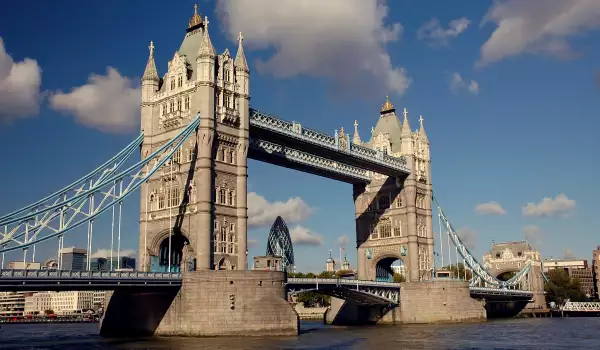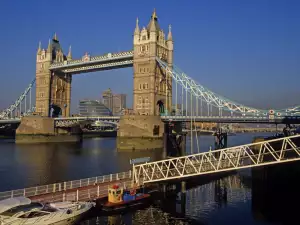Tower Bridge

Tower Bridge in London is one of the emblematic buildings in the capital. It was officially opened by the Prince of Wales and future King of England – Edward VII, which cuts the official ribbon on June 30, 1894 Today the Tower Bridge is still celebrated as one of the most important and valuable buildings in London.
It is a lift bridge over the Thames River. Tower Bridge is located near the Tower of London, from which it takes its name. Other major bridges over the Thames are London Bridge, located slightly west of Tower Bridge and next to it the famous Millenium Bridge. Millennium Bridge is the newest of all the bridges, it was open on June 10, 2000 and is the first fully pedestrian area.
In the 19th century, the eastern port of London is too densely populated and not close to any of the other bridges. That required the construction of Tower Bridge. In 1876 was composed a "Special Commission for bridges and underground roads" which began to measure underground and surface crossing of the Thames. The most important objective was that the bridge does not hinder waterway navigation. More than 50 project ideas were presented to the special committee and one of them got approved only in 1884
Construction of the bridge began in 1886 and lasted eight years. Officially opened on June 30 1894, in the royal presence of the Prince of Wales - the future King Edward VII and his wife - Alexandra of Denmark. Tower Bridge reaches a length of 244 meters and has two towers of 65 meters high, each of which weighs 1000 tons. For the preparation of the metal structure of the Tower Bridge were needed 11, 000 tons steel. The two towers and connecting pedestrian lanes are lined with granite from Cornwall and stone from Portland. During the construction of Tower Bridge were involved 432 employees and five large building contractors.
Tower Bridge is a combination lift and suspension bridge, it is composed of two towers that are connected by two horizontal connecting passages. Their main goal is for the bridge to withstand the horizontal forces that it has been subjected to. 100 years ago, Tower Bridge was hydraulically powered by steam engines, which produced energy for the six batteries. They in turn raise the "scissor" bridge to a maximum angle of 86 degrees and that takes about one minute time. Today the power of steam is replaced by electricity.

As a tourist attraction, it was decided to keep the original pumps, generators and batteries of Tower Bridge, which can be seen in both towers. Annually the "scissors" have to open the bridge about 900 times to miss the passing ships. Mandatory requirement that all vessels over 14 meters high are subject to a written notice at least 24 hours before passing under Tower Bridge.
Pedestrian lanes of the bridge are located at a height of 45 meters above the river and are designed so that the flow of people does not stop even when the "scissors" are open. Around 1910, they were almost never used and had a bad reputation as a haunt of prostitutes and criminals. They were closed, but by 1982 it is fully glazed and hiking trails are open. Annually, through the pedestrian paths, 380 000 tourists cross Tower Bridge. Every day about 40 000 pedestrians, cyclists and motorists pass through Tower Bridge.
Tower Bridge was built in a beautiful Gothic-Victorian style and is often used for natural scenery of large theatre productions, such as Sherlock Holmes in 2009, The Mummy Returns and others.















